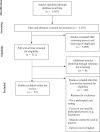Measurement and monitoring patient safety in prehospital care: a systematic review
- PMID: 33459774
- PMCID: PMC10517741
- DOI: 10.1093/intqhc/mzab013
Measurement and monitoring patient safety in prehospital care: a systematic review
Abstract
Background: Prehospital care is potentially hazardous with the possibility for patients to experience an adverse event. However, as compared to secondary care, little is known about how patient safety is managed in prehospital care settings.
Objectives: The objectives of this systematic review were to identify and classify the methods of measuring and monitoring patient safety that have been used in prehospital care using the five dimensions of the Measuring and Monitoring Safety (MMS) framework and use this classification to identify where there are safety 'blind spots' and make recommendations for how these deficits could be addressed.
Methods: Searches were conducted in January 2020, with no limit on publication year, using Medline, PsycInfo, CINAHL, Web of Science and Academic Search. Reference lists of included studies and existing related reviews were also screened. English-language, peer-reviewed studies concerned with measuring and monitoring safety in prehospital care were included. Two researchers independently extracted data from studies and applied a quality appraisal tool (the Quality Assessment Tool for Studies with Diverse Designs).
Results: A total of 5301 studies were screened, with 52 included in the review. A total of 73% (38/52) of the studies assessed past harm, 25% (13/52) the reliability of safety critical processes, 1.9% (1/52) sensitivity to operations, 38.5% (20/52) anticipation and preparedness and 5.8% (3/52) integration and learning. A total of 67 methods for measuring and monitoring safety were used across the included studies. Of these methods, 38.8% (26/67) were surveys, 29.9% (20/67) were patient records reviews, 14.9% (10/67) were incident reporting systems, 11.9% (8/67) were interviews or focus groups and 4.5% (3/67) were checklists.
Conclusions: There is no single method of measuring and monitoring safety in prehospital care. Arguably, most safety monitoring systems have evolved, rather than been designed. This leads to safety blind spots in which information is lacking, as well as to redundancy and duplication of effort. It is suggested that the findings from this systematic review, informed by the MMS framework, can provide a structure for critically thinking about how safety is being measured and monitored in prehospital care. This will support the design of a safety surveillance system that provides a comprehensive understanding of what is being done well, where improvements should be made and whether safety interventions have had the desired effect.
Keywords: emergency medical services; prehospital; safety measurement; safety monitoring; systematic review.
© The Author(s) 2021. Published by Oxford University Press on behalf of International Society for Quality in Health Care. All rights reserved. For permissions, please e-mail: journals.permissions@oup.com.
References
-
- Bigham BL, Bull E, Morrison M et al. Patient safety in emergency medical services: executive summary and recommendations from the Niagara Summit. Can J Emerg Med 2011;13:13–18. - PubMed
-
- Vincent C, Burnett S, Carthey J. The Measurement and Monitoring of Safety: Drawing Together Academic Evidence and Practical Experience to Produce a Framework for Safety Measurement and Monitoring. London: The Health Foundation, 2013.
-
- Bigham BL, Buick JE, Brooks SC et al. Patient safety in emergency medical services: a systematic review of the literature. Prehosp Emerg Care 2012;16:20–35. - PubMed
Publication types
MeSH terms
LinkOut - more resources
Full Text Sources
Other Literature Sources
Medical
Miscellaneous


